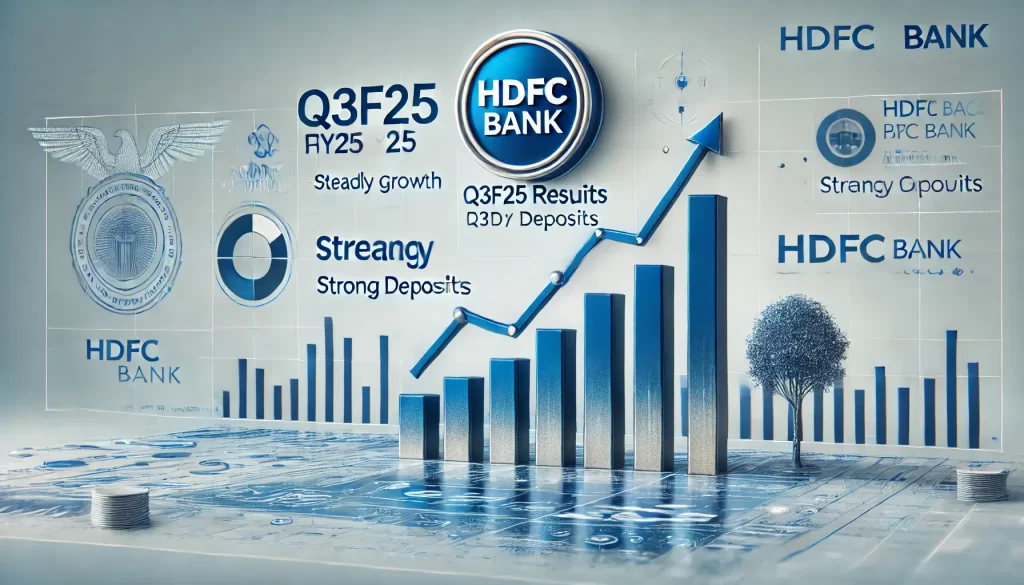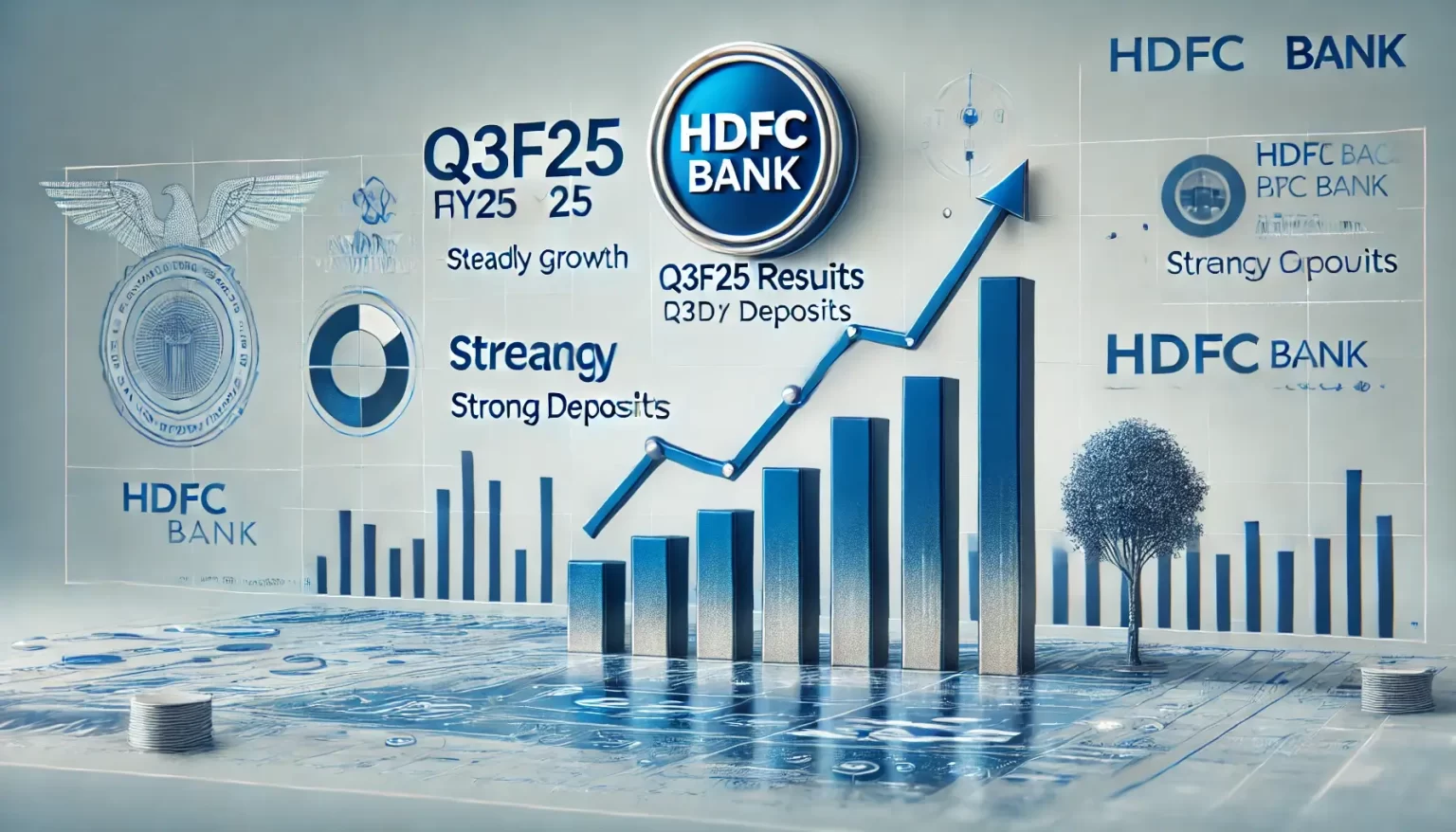Hdfc bank q3 results: HDFC Bank, one of India’s leading private sector banks, recently announced its financial results for the third quarter of the finincial year 2024-25 (Q3FY25). The results reflect the bank’s steady performance and provide insights into its strategy and operations.
Here’s a detailed breakdown of the results, their implications, and what investors should know before making investment decisions.
“I write reviews of individual stocks from the Nifty 50 index on my site, such as why to invest in companies like TCS, IRFC, Yes Bank, etc. Feel free to explore my work if you’re interested.”
HDFC Bank’s Q3FY25 Results: Key Highlights
- Net Profit Meets Expectations
HDFC Bank reported a steady net profit for Q3FY25, meeting market expectations. This reflects the bank’s ability to maintain profitability despite a challenging economic environment. - Focus on Deposit Growth
The bank has emphasized deposit growth over credit expansion. This aligns with its strategy to lower the loan-to-deposit ratio (LDR) to pre-COVID levels. The focus on deposit accumulation has contributed to stable growth in deposits, ensuring a strong liquidity position. - Slower Credit Growth
Credit growth for HDFC Bank was slower compared to industry standards. This was a deliberate move by the management, as they prioritize deposit growth and aim to maintain a healthy balance sheet. While this may seem like a conservative approach, it ensures long-term financial stability. - Slight Decline in Asset Quality
There was a minor decline in asset quality during Q3FY25. However, HDFC Bank’s strong underwriting standards and risk-calibrated lending practices have enabled it to maintain overall robust asset quality. - Strong Long-Term Vision
Despite challenges, the bank’s strategy reflects a long-term focus. The steady deposit growth and disciplined lending practices demonstrate a commitment to sustainable growth.
Management Commentary
Abhishek Pandya, a Research Analyst at StoxBox, shared his views on HDFC Bank’s performance:
“HDFC Bank reported steady Q3FY25 results, with net profit meeting market expectations.
In its Q2FY25 commentary, management outlined a strategy to lower the LDR to pre-COVID levels, resulting in slower credit growth compared to industry standards while focusing on deposit accumulation, which is evident in Q3FY25 performance.
Despite muted credit expansion, steady deposit growth aligns well with the bank’s long-term goals. Although there was a slight decline in asset quality, HDFC Bank has consistently maintained strong asset quality through disciplined underwriting and risk-calibrated lending.”
What Does This Mean for Investors?
If you’re considering investing in HDFC Bank, here’s what you need to understand:
1. Stable Performance
HDFC bank’s Q3FY25 results highlight its resilience and ability to navigate economic challenges. Meeting net profit expectations is a positive sign for investors looking for steady returns.
2. Deposit Growth as a Key Driver
By prioritizing deposit growth, HDFC Bank is building a strong foundation for future lending activities. A solid deposit base ensures the bank has sufficient funds to support credit expansion when required.
3. Conservative Lending Approach
The slower credit growth reflects a cautious approach, prioritizing quality over quantity. This strategy may result in stable returns over the long term, reducing the risk of bad loans.
4. Robust Risk Management
HDFC Bank’s strong asset quality, despite a slight decline, showcases its commitment to disciplined risk management. For investors, this reduces concerns about potential losses from non-performing assets (NPAs).
5. Long-Term Sustainability
The bank’s focus on aligning with pre-COVID levels and sustainable practices indicates a long-term vision. Investors with a long-term horizon may find this approach appealing.
Challenges to Consider
While HDFC Bank’s Q3FY25 results are promising, there are some challenges to keep in mind:
- Muted Credit Growth
Slower credit growth may limit short-term profitability. However, the focus on sustainability could offset this concern in the long run. - Competitive Environment
The banking sector is highly competitive, with other private banks showing faster credit growth. This could impact HDFC Bank’s market share if the strategy isn’t balanced effectively. - Macroeconomic Uncertainty
Economic factors such as inflation, interest rate fluctuations, and global market conditions could affect the bank’s performance.
Comparing HDFC Bank with Industry Peers
HDFC Bank’s performance in Q3FY25 can be better understood by comparing it with its peers in the private banking sector:
| Metric | HDFC Bank | ICICI Bank | Axis Bank | Kotak Mahindra Bank |
|---|---|---|---|---|
| Net Profit Growth | Steady | Strong | Moderate | Consistent |
| Deposit Growth | High | Moderate | High | Moderate |
| Credit Growth | Slower | Strong | Moderate | Slower |
| Asset Quality | Strong | Strong | Moderate | Strong |
HDFC Bank’s cautious approach stands out, while others may have opted for more aggressive credit growth.
Why HDFC Bank Remains a Top Choice for Investors
1. Strong Brand and Reputation
HDFC Bank is one of India’s most trusted private banks, known for its customer-centric approach and innovative financial solutions.
2. Technological Advancements
The bank continues to invest in technology, enhancing its digital banking capabilities and improving customer experience.
3. Experienced Management
HDFC Bank’s leadership team has consistently demonstrated the ability to steer the bank through economic challenges, ensuring stable growth.
4. Attractive Valuation
Despite the challenges, HDFC Bank’s stock remains attractively priced, offering potential for capital appreciation.
Conclusion: Should You Invest in HDFC Bank?

HDFC Bank’s Q3FY25 results highlight its steady performance and long-term focus. While the slower credit growth may concern short-term investors, the bank’s robust risk management and emphasis on deposit growth ensure a strong foundation for the future.
If you’re a long-term investor looking for stability and sustainable growth, HDFC Bank could be a valuable addition to your portfolio.
However, it’s essential to consider your investment goals, risk tolerance, and market conditions before making a decision. Stay updated with the latest financial news and insights to make informed investment choices.
What is Brokerage house view on HDFC Bank,
Brokerage firms have shared their perspectives on HDFC Bank’s performance and future prospects. Here’s a summary of their views:
1. Jefferies
Maintains a ‘Buy‘ rating with a target price increased to Rs 2,120 from Rs 2,020),. They note that the bank’s pre-provision operating profit aligns with expectations, highlighting a slight increase in net interest margins and strong deposit growth of 17%. Read more here
2. Nomura
Holds a ‘Neutral’ stance, adjusting the target price to ₹1,660 per share. They observe a gradual adjustment phase, anticipating loan growth of 12-13% and deposit growth at a 17% compound annual growth rate over fiscal years 2024 to 2026. Nomura estimates a return on equity of approximately 14-15% for FY25-26.
3. ICICI Securities
Upgrades to a ‘Buy’ rating with a target of ₹1,850 per share. They highlight the bank’s strong return on assets and a significant reduction in borrowings.
Despite revising loan growth estimates to 13%, they expect HDFC Bank to maintain a healthy return on assets of nearly 1.7% for FY25-26, with a return on equity of 14-15%.
4. Motilal Oswal
Issues a ‘Buy’ call with a target price of ₹1,950 per share. They find the bank’s core performance in line with expectations, noting an improvement in margins compared to the previous quarter.
They anticipate a compound annual growth rate of 13.5% to 18% in loans and deposits over FY24-26, leading to a return on assets/return on equity of 1.9%/15.5% by FY26.
5. Morgan Stanley
Maintains an ‘Overweight’ rating with a target of ₹1,900 per share, emphasizing strong improvements in liquidity coverage ratio and margins.
In summary, while some brokerages adopt a cautious stance, the general outlook on HDFC Bank remains positive, with expectations of steady growth and profitability in the coming years.
What you do after HDFC Q3 results, buy/hold?
Based on HDFC Bank’s Q3FY25 results and the views of various brokerage houses, here’s a my analysis to help my readers decide whether to **buy**, **hold**, or take other actions:
#1. Key Factors Supporting a Buy Decision
- Steady Net Profit Growth: HDFC Bank met market expectations, showing stable performance.
- Strong Deposit Growth: The bank’s focus on deposit accumulation creates a solid foundation for future growth.
- Improved Margins: Margins have shown improvement, indicating better profitability potential.
- Robust Risk Management: Despite a minor dip, asset quality remains strong due to disciplined lending.
- Brokerage Support: Several brokerages, including Jefferies, ICICI Securities, and Motilal Oswal, maintain a positive outlook with target prices ranging between ₹1,850 to ₹2250.
Recommendation:
Investors with a long-term horizon and low-risk tolerance can consider buying HDFC Bank shares at current levels. It is a strong, stable bank with consistent growth potential.
#2. Key Reasons to Hold
- Conservative Growth Approach: Slower credit growth might limit short-term gains.
- Macroeconomic Uncertainty: Factors like inflation or rate changes could affect the banking sector.
- Neutral Stance by Some Analysts: Brokerages like Nomura suggest a cautious approach with modest growth expectations.
Our Recommendation:
If you already hold HDFC Bank shares, consider **holding** them for steady returns. The bank’s focus on sustainability will benefit patient investors.
#3. When to Avoid or Sell
- Short-Term Traders: Those looking for quick profits may find better opportunities in banks with aggressive credit growth.
- High Risk-Tolerance Investors: Investors willing to take risks may explore other stocks in sectors like technology or infrastructure for higher returns.
Our Recommendation:
If your investment goal is aggressive short-term growth, you might look at other stocks while keeping HDFC Bank on your watchlist.
#Bottom Line
- Long-Term Investors: Buy** or **hold** for consistent returns and lower risk.
- Short-Term Investors: Wait for a better entry point or focus on growth-driven stocks in other sectors.
HDFC Bank remains a strong pillar in the Indian banking sector, and its long-term prospects look promising. As always, ensure you align investment decisions with your financial goals and risk appetite.






